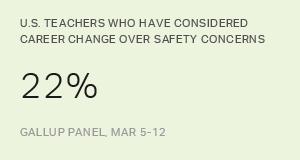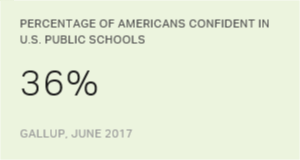Story Highlights
- 41% of teachers say digital devices are helpful to students' education
- Most see devices as harmful to students' physical and mental health
- Parents have much more positive views of digital devices than teachers
WASHINGTON, D.C. -- Teachers in the U.S. are slightly more likely to see student use of digital devices as having a positive rather than negative effect on the overall education of students. In contrast, they are far more negative about the effects of those devices on students' physical and mental health.
| Mostly helpful | Neither helpful nor harmful | Mostly harmful | |||||||||||||||||||||||||||||||||||||||||||||||||||||||||||||||||||||||||||||||||||||||||||||||||
|---|---|---|---|---|---|---|---|---|---|---|---|---|---|---|---|---|---|---|---|---|---|---|---|---|---|---|---|---|---|---|---|---|---|---|---|---|---|---|---|---|---|---|---|---|---|---|---|---|---|---|---|---|---|---|---|---|---|---|---|---|---|---|---|---|---|---|---|---|---|---|---|---|---|---|---|---|---|---|---|---|---|---|---|---|---|---|---|---|---|---|---|---|---|---|---|---|---|---|---|
| % | % | % | |||||||||||||||||||||||||||||||||||||||||||||||||||||||||||||||||||||||||||||||||||||||||||||||||
| Effects of digital devices on students' education | 42 | 30 | 28 | ||||||||||||||||||||||||||||||||||||||||||||||||||||||||||||||||||||||||||||||||||||||||||||||||
| Effects of digital devices on students' physical health | 4 | 42 | 55 | ||||||||||||||||||||||||||||||||||||||||||||||||||||||||||||||||||||||||||||||||||||||||||||||||
| Effects of digital devices on students' mental health | 4 | 27 | 69 | ||||||||||||||||||||||||||||||||||||||||||||||||||||||||||||||||||||||||||||||||||||||||||||||||
| U.S. teacher poll | |||||||||||||||||||||||||||||||||||||||||||||||||||||||||||||||||||||||||||||||||||||||||||||||||||
| GALLUP PANEL, March 5-12, 2018 | |||||||||||||||||||||||||||||||||||||||||||||||||||||||||||||||||||||||||||||||||||||||||||||||||||
The nationally representative March 5-12 poll of U.S. teachers finds that more than four in ten K-12 teachers say students' use of digital devices has a "mostly helpful" effect on students' education, while 28% of teachers instead describe the effect of these devices as "mostly harmful."
Meanwhile, an overwhelming majority of teachers in the U.S. (69%) believe students' use of digital devices has mostly harmful effects on students' mental health; a slightly smaller share of teachers (55%) express this concern with respect to students' physical health.
While estimates vary, there is little doubt that a substantial share of K-12 students own and regularly bring some type of digital device to school. According to 2015 research by the educational organization Pearson, majorities of students at all grade levels own a smartphone, including 53% of elementary school students, 65% of middle school students and 82% of high school students. Separately, Pew Research estimated in 2015 that more than two-thirds of teens (72%) own smartphones.
Despite their potential use to students, researchers and education policymakers remain divided as to whether these devices can be effective learning tools for students. Most schools have banned the use of cellphones by students, though this number has declined in recent years. These results suggest that while the greater share of teachers see the educational potential of these types of technology, there is no broad consensus among teachers.
Parents More Positive Than Teachers on Digital Devices
In a separate study, Gallup found broad majorities of U.S. parents of school-aged children expressing optimism about the effects of digital device use on their children. As was the case with teachers, parents were most positive about the effect digital devices will have on their children's education, with 87% saying the effect of these devices will be "mostly helpful," and 13% saying "mostly hurtful." Most parents also believed digital devices would have a helpful effect on their children's physical and mental health.*
Nearly Half of K-8 Teachers See Devices as Helpful to Students' Education
By a nearly 2-1 margin, elementary and middle school teachers are more likely to see students' use of digital devices as more helpful than harmful to their students' education, with 48% expressing the former sentiment and 23% the latter.
Teachers of high school students, where ownership of certain digital devices is nearly universal, are less positive about the educational impact of these devices than their counterparts. Nearly as many high school teachers see the effect of these devices on students' education as mostly helpful as see it as mostly harmful, at 36% and 34%, respectively.
| Mostly helpful | Neither helpful nor harmful | Mostly harmful | |||||||||||||||||||||||||||||||||||||||||||||||||||||||||||||||||||||||||||||||||||||||||||||||||
|---|---|---|---|---|---|---|---|---|---|---|---|---|---|---|---|---|---|---|---|---|---|---|---|---|---|---|---|---|---|---|---|---|---|---|---|---|---|---|---|---|---|---|---|---|---|---|---|---|---|---|---|---|---|---|---|---|---|---|---|---|---|---|---|---|---|---|---|---|---|---|---|---|---|---|---|---|---|---|---|---|---|---|---|---|---|---|---|---|---|---|---|---|---|---|---|---|---|---|---|
| % | % | % | |||||||||||||||||||||||||||||||||||||||||||||||||||||||||||||||||||||||||||||||||||||||||||||||||
| K-8 | 48 | 29 | 23 | ||||||||||||||||||||||||||||||||||||||||||||||||||||||||||||||||||||||||||||||||||||||||||||||||
| 9-12 | 36 | 30 | 34 | ||||||||||||||||||||||||||||||||||||||||||||||||||||||||||||||||||||||||||||||||||||||||||||||||
| U.S. Teacher poll | |||||||||||||||||||||||||||||||||||||||||||||||||||||||||||||||||||||||||||||||||||||||||||||||||||
| GALLUP PANEL, March 5-12, 2018 | |||||||||||||||||||||||||||||||||||||||||||||||||||||||||||||||||||||||||||||||||||||||||||||||||||
Majority of Teachers Under 40 See Effect of Digital Devices Positively
Younger teachers (40 or younger) are more likely than their older counterparts to see the digital devices as helpful to students' overall education. Fifty-one percent of teachers under the age of 40 say digital devices will have "mostly helpful" effects on students' education, compared with the 36% of teachers aged 40 and older who agree with this sentiment. And while 22% of U.S. teachers under 40 see the use of digital devices in students' education as "mostly harmful," 32% of teachers over 40 say the same.
| Mostly helpful | Neither helpful nor harmful | Mostly harmful | |||||||||||||||||||||||||||||||||||||||||||||||||||||||||||||||||||||||||||||||||||||||||||||||||
|---|---|---|---|---|---|---|---|---|---|---|---|---|---|---|---|---|---|---|---|---|---|---|---|---|---|---|---|---|---|---|---|---|---|---|---|---|---|---|---|---|---|---|---|---|---|---|---|---|---|---|---|---|---|---|---|---|---|---|---|---|---|---|---|---|---|---|---|---|---|---|---|---|---|---|---|---|---|---|---|---|---|---|---|---|---|---|---|---|---|---|---|---|---|---|---|---|---|---|---|
| % | % | % | |||||||||||||||||||||||||||||||||||||||||||||||||||||||||||||||||||||||||||||||||||||||||||||||||
| Under 40 | 51 | 27 | 22 | ||||||||||||||||||||||||||||||||||||||||||||||||||||||||||||||||||||||||||||||||||||||||||||||||
| 40+ | 36 | 32 | 32 | ||||||||||||||||||||||||||||||||||||||||||||||||||||||||||||||||||||||||||||||||||||||||||||||||
| U.S. Teacher poll | |||||||||||||||||||||||||||||||||||||||||||||||||||||||||||||||||||||||||||||||||||||||||||||||||||
| GALLUP PANEL, March 5-12, 2018 | |||||||||||||||||||||||||||||||||||||||||||||||||||||||||||||||||||||||||||||||||||||||||||||||||||
Among all U.S. adults, younger individuals tend to rely on their digital devices more frequently than older adults; they also exhibit greater levels of attachment to these devices relative to older age groups. If these broad patterns apply to teachers, young teachers may have more favorable views of the educational value of digital devices due to their greater familiarity with and reliance on the technology.
Bottom Line
Despite major growth in the educational technology industry and widespread adoption of digital devices in schools across the U.S., only a slight plurality of teachers see these tools as helpful to students' education -- and decisive majorities see them as harmful to students' physical or mental health. The implications of these findings for schools and educational technology providers are potentially significant. Without strong support from teachers regarding the value of digital devices in the classroom, the promise of technology in education won't be fully realized.
Studies suggest that ownership of digital devices will only continue to grow in the future. If these powerful resources are to be integrated in a productive way into students' education, schools must take appropriate action -- including professional development programs for teachers on using digital devices in classrooms.
Regardless, the overall skeptical view among teachers about digital devices and students calls for more research to understand how, why, when, where and for whom this technology is helpful or hurtful -- and in what ways. Additionally, the apparent divide between educators and parents on this matter further suggests additional research is necessary to better understand how technology can aid the learning process.
Survey Methods
Results are based on a Gallup Panel web study completed by 497 national adults, aged 18 and older, who teach K-12 students in the U.S. The survey was conducted March 5-12, 2018. The Gallup Panel is a probability-based longitudinal panel of U.S. adults who are selected using random-digit-dial (RDD) phone interviews that cover landlines and cellphones. Address-based sampling methods are also used to recruit panel members. The Gallup Panel is not an opt-in panel and members are not given incentives for participating. For results based on this sample, one can say that the margin of sampling error is ±7 percent, at the 95% confidence level. Margins of error are higher for subsamples. In addition to sampling error, question wording and practical difficulties in conducting surveys can introduce error or bias into the findings of public opinion polls.
*These data are based on results from an online web-based survey with 1,000 U.S. adults who are parents of children aged 2-18. The study was fielded using the Survey Sampling International (SSI) panel of consumers and was fielded Jan. 12-14, 2018.
Learn more about how the Gallup Panel works.






